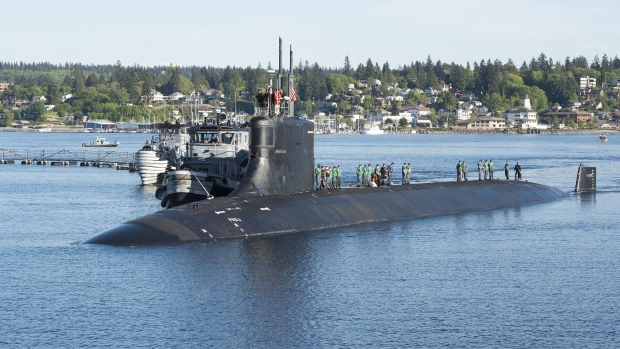風蕭蕭_Frank
以文會友
正文
由於造船廠堵塞,在南海受損的美國潛艇要到 2026 年才能返回
托尼·卡帕喬,彭博社

2018 年的康涅狄格號。來源:Smith Collection/Gado/Getty Images

2018 年的康涅狄格號。來源:Smith Collection/Gado/Getty Images,來源:Smith Collection/Gado/Getty Images
(彭博社)——據美國海軍稱,康涅狄格號潛艇是 19 個月前在南中國海撞上一座水下山峰的頂級潛艇,最快要到 2026 年初才能恢複服役,這進一步增加了積壓的訂單 隨著美國麵對不斷壯大的中國艦隊,維修大修成為可能。
康涅狄格號是三艘先進的海狼號潛艇之一,於 2021 年 10 月 2 日撞上了未知的海山。據海軍稱,船首和下舵的維修費用估計為 8000 萬美元。 按照五角大樓的標準,這是一筆不小的數目,但等待該船返回服役的漫長等待凸顯了海軍四個造船廠的維護問題。
“康涅狄格州的維修傳奇凸顯了海軍缺乏維修激增能力,”政府問責辦公室防務準備評估主任戴安娜毛雷爾說。 “這反過來又引發了關於海軍在發生衝突時如何進行戰損修複的問題。”
近年來,GAO 多次記錄了阻礙海軍潛艇準備就緒的延誤。
國防官員和立法者認為美國潛艇部隊相對於數量更多的中國海軍來說是一個關鍵優勢。 但政府問責辦公室在 2022 年關於美國對華能力的總結中表示,從 2008 年到 2018 年,海軍損失了 10,363 個作戰日——相當於超過 28 年——“由於進出造船廠的延誤。”
GAO 最近的另一項評估發現,從 2014 財年到 2020 財年,海軍潛艇在基地維修的時間比預期多 9,563 天。
參議院軍事委員會的最高共和黨人、來自密西西比州的羅傑·威克周三在一條推文中表示,彭博新聞社報道的“我們最強大的潛艇之一”的五年維修時間表“提醒我們需要什麽樣的巨大投資 建造海洋基礎設施。”
康涅狄格號由通用動力公司建造,於 1998 年服役。調查發現,造成 11 名船員輕傷的事故是可以避免的。 該船的指揮官、執行官和高級士兵被解除了指揮職務。
台灣,海上航線
根據海軍記錄,現在,它是海軍 49 艘快速攻擊潛艇中的 18 艘——或超過該艦隊的三分之一——停止服役,要麽在基地維修,要麽等待進入該階段。 快速攻擊潛艇發射魚雷和戰斧巡航導彈,這將使它們成為在台灣或南中國海航道上與中國進行潛在戰鬥的關鍵船隻。
閱讀更多:美國海軍在台灣演習中在南中國海挑戰北京
傳統基金會海戰高級研究員布倫特·薩德勒 (Brent Sadler) 說:“公共造船廠產能有限,推遲了這艘獨特的特殊任務潛艇盡快恢複服役”,因此它“將在不可接受的五年內退役” 和一位經曆過多次潛艇之旅的海軍老兵。
GAO 的毛雷爾表示,海軍可能會將“稀缺的造船廠空間”放在航空母艦和彈道導彈潛艇的首要位置,“這意味著攻擊潛艇更有可能閑置時間等待進入可用的幹船塢。”
康涅狄格號是美國三艘核動力海狼級潛艇中的一艘,是該軍種最大的攻擊潛艇,旨在與蘇聯作戰。 海軍將該級描述為“異常安靜、速度快、裝備精良,並配備了先進的傳感器”。 它有八個魚雷發射管,魚雷艙內可容納多達 50 件武器。
國會研究服務處的海軍分析員羅納德·奧魯克 (Ronald O'Rourke) 表示,延誤部分反映了“現代軍艦複雜性的產物——因此修複它們損壞所需的工作也很複雜。”
康涅狄格號目前停泊在華盛頓州一家海軍造船廠的碼頭邊,等待原定於 2 月開始的維修期開始。 海軍在一份聲明中說,現在預計在幹船塢加固改造完成後的下個月開始,幹船塢將在那裏進行修複以抵抗地震顫動。
“潛艇維修延誤的一些主要驅動因素是計劃、材料可用性和船廠執行,”該服務稱。 海軍的“潛艇保障領導層正在執行多項舉措,以解決維護延誤的其他驅動因素。” 它說。
US Submarine Damaged in South China Sea Won’t Return Until 2026 as Shipyards Are Clogged
https://www.bnnbloomberg.ca/us-submarine-damaged-in-south-china-sea-won-t-return-until-2026-as-shipyards-are-clogged-1.1932917
Tony Capaccio, Bloomberg News
The USS Connecticut in 2018. Source: Smith Collection/Gado/Getty Images
The USS Connecticut in 2018. Source: Smith Collection/Gado/Getty Images , Source: Smith Collection/Gado/Getty Images
(Bloomberg) -- The USS Connecticut, a premier submarine that struck an underwater mountain in the South China Sea 19 months ago, won’t be back in service until early 2026 at the soonest, according to the US Navy, adding to a backlog of maintenance overhauls as the US faces a growing Chinese fleet.
The Connecticut, one of three advanced Seawolf submarines, hit the uncharted seamount on Oct. 2, 2021. The repairs to the bow and lower rudder will cost an estimated $80 million, according to the Navy. That’s a modest sum by Pentagon standards, but the long wait for the vessel’s return to service highlights problems with maintenance at the Navy’s four shipyards.
“The Connecticut’s repair saga underscores the Navy’s lack of repair surge capacity,” said Diana Maurer, a director of the Government Accountability Office’s defense readiness evaluations. “That in turn raises questions about how the Navy would execute battle damage repairs in the event of conflict.”
Delays hobbling the readiness of Navy submarines have been documented repeatedly in recent years by the GAO.
Defense officials and lawmakers consider the US submarine force a key advantage over a numerically larger Chinese navy. But the GAO said in a 2022 summary about US capabilities against China that the Navy lost 10,363 operational days from 2008 through 2018 — the equivalent of more than 28 years — “as a result of delays in getting into and out of the shipyards.”
Another recent GAO assessment found that from fiscal year 2014 to fiscal 2020, Navy submarines had spent 9,563 more days in depot maintenance than expected.
The Senate Armed Services Committee’s top Republican, Roger Wicker of Mississippi, said in a tweet Wednesday that the five-year repair timetable reported by Bloomberg News for “one of our most formidable submarines” is “a reminder of the kinds of monumental investments we need to make in maritime infrastructure.”
The Connecticut, built by General Dynamics Corp., was commissioned for service in 1998. An investigation found its accident, which caused minor injuries to 11 sailors, was preventable. The vessel’s commander, executive officer and senior enlisted officer were relieved of command.
Taiwan, Sea Lanes
Now, it’s among 18 of the Navy’s 49 fast-attack subs — or more than one-third of that fleet — that are out of service, either in depot maintenance or awaiting to enter that phase, according to Navy records. Fast-attack subs fire torpedoes and Tomahawk cruise missiles, which would make them crucial vessels in a potential fight against China over Taiwan or South China Sea lanes.
Read more: US Navy Challenges Beijing in South China Sea Amid Taiwan Drills
“Limited public shipyard capacity has delayed a sooner return-to-service of this unique, special-missions submarine” so it “will be out of service an unacceptable five years,” said Brent Sadler, the Heritage Foundation’s senior research fellow for naval warfare and a Navy veteran with numerous submarine tours.
Maurer of the GAO said the Navy may be giving top priority “for scarce shipyard space” to aircraft carriers and ballistic-missile submarines, “which means attack subs are more likely to rack up idle time waiting to get into an available dry dock.”
The Connecticut is one on the US’s three nuclear-powered Seawolf-class vessels, the service’s largest attack subs, which were designed to fight the Soviet Union. The Navy describes the class as “exceptionally quiet, fast, well-armed, and equipped with advanced sensors.” It has eight torpedo tubes and can hold as many as 50 weapons in its torpedo room.
Ronald O’Rourke, a naval analyst with the Congressional Research Service, said the delay reflects in part “a product of the complexity of modern warships — and thus the complexity of the work needed to repair damage to them.”
The Connecticut is currently dockside at a naval shipyard in Washington state awaiting the start of a maintenance period that was to begin in February. It’s now expected to begin next month after the completion of improvements to harden the dry dock where it will be repaired against earthquake tremors, the Navy said in a statement.
“Some of the primary drivers of submarine maintenance delays are planning, material availability, and shipyard execution,” according to the service. The Navy’s “submarine sustainment leadership is executing multiple initiatives to address other drivers of maintenance delays.” it said.
評論
目前還沒有任何評論
登錄後才可評論.




